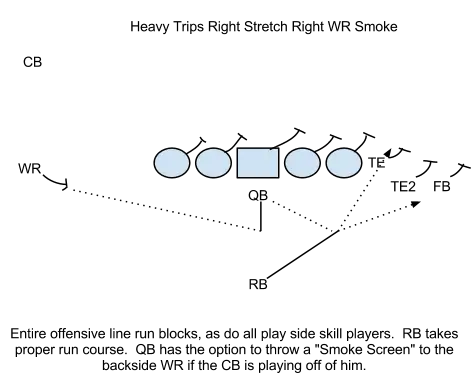A note from FishDuck.com: Today we have a unique treat, this article from a highly successful coach gives an inside perspective football fans don’t often get to see, the direct insight of football concepts and experiences from a coach in the know. This week Coach Jason Farias provides his insight, an assistant coach with the Boston Militia of the WFA (Women’s Football Association) and offensive coordinator the Charleston Townies of the EFL (Eastern Football League).
We encourage other coaches that are interested in possibly writing guest columns providing their unique insight to please contact us. For now, here is Coach Jason Farias!
No matter the style of play that a team chooses to employ on offense–whether they’re a three-yards-and-a-cloud-of-dust power football team or a pass-happy spread attack–defensive coaches across the football landscape have been quick to adapt to and counter the ever-evolving nature of football. While mad scientists such as Chip Kelly, Mike Leach, Noel Mazzone, and Dana Holgorsen continue to push the envelope of offensive innovation; defensive coordinators could take solace in knowing that there was no such thing as a perfect play. Regardless of scheme, there was always an answer to anything the opposing offense wanted to do.
But what if an offense could choose a play that, if executed properly, was always correct no matter the defense’s actions?
Since the beginning stages of the game, offenses have been trying to create flexibility within their system. Initially, a quarterback could have the option of running a play to one side or the other depending on the defense’s alignment. Balanced formations such as the wishbone were popular because they didn’t have a so-called strong side and weak side, which meant that defenses couldn’t guess the play based on offensive alignment. This allowed the quarterback to come to the line of scrimmage, analyze defensive alignment and check into the right play based on what was seen.

The next progression of offensive flexibility involved a quarterback who was given two (or more) play calls for a given down by the offensive coordinator; the initial called play and the “check-into” play. The quarterback would scan the defense, and then either go with the original play call or the “check-into” play based on the defense.
Here is an example of such a way to combine plays, with a run called to the right and a play-action off the run called to the left.
While this was a logical way to counter a defense that was set to stop a certain play, it did have some disadvantages. First, since the coordinator called two (or more) completely different plays, with potentially two (or more) different formations, it made the play call very long. Especially at the collegiate and high school levels, where quarterbacks are devoid of headsets, this is a lot to remember for all the players, and possibly cause miscommunication resulting in broken plays. Try saying, “Train Right Nasty Fake Whiz 965 H Shallow Kill Far Right Jazz 36 Power O” after hearing (or in this case, reading) it just once!
The bigger hindrance to this play-calling system was the adaptability of defenses. Just like the offense, a defense could switch their alignment and their play call after the original play was “killed,” possibly nullifying any advantage gained. The defense would initially align in a way which would cause the quarterback to “kill” the original play, thereby informing the offense of the decision to go with the second option. Then, the defense would completely alter its configuration after the audible was made, making the offense’s audible inefficient.

Another creative step forward for offenses was to call one play in the huddle, but give the quarterback the ability to run a one-man route on the backside if he liked the alignment of the defense. Everyone on the offense would execute the given play call, except for the quarterback and backside receiver. Most often, the backside route would be some kind of quick route such as a “smoke screen” or slant. This concept is diagrammed below, in which case a “smoke screen” is used against “off-coverage” by the cornerback.
While the aforementioned tactics have worked well at all levels of football, it was only a matter of time before offensive coaches would further push the envelope of innovation. It has been widely accepted that an effective way to counter a defense which tries to stop an offense’s base plays is through the use of constraints.
Systems such as the Oregon Ducks’ spread zone read scheme use constraint plays as a way to keep a defense honest so that it doesn’t overreact to a specific look. An offense needs to have answers once the defense begins to take away their bread and butter plays and concepts. The newest rage, especially evident in spread offenses, is the idea of creating packaged plays. When combining two (or more) distinct concepts into a single play, offenses are able to give the defense multiple looks to stop at once.
Packaged plays are effective for multiple reasons. They don’t require an entire offense to learn any new concepts; rather, offenses can continue to run their base plays. This allows for continued repetition, and less learning of new material. An offense can combine two staple components of their system into one play, such as a base run with a quick passing play.
By having two or more distinct concepts in a single play, an offense can often try to isolate a single defender and give him two responsibilities at once. By making him choose between them, the offense is thereby causing him to be wrong no matter his choice.
If the idea of isolating a defensive player and giving him two choices sounds familiar, that’s because it has been around the game of football since the game’s infancy–called “option” football. Unlike traditional option offenses, or even the spread-option systems that have been en vogue recently, packaged plays allow an offense more freedom in terms of whom they are attacking. While traditional option offenses would attack defensive linemen, packaged plays allow for an offense to attack other players such as linebackers and safeties.
Offenses that use a spread passing attack have been using different types of packaged plays for a few seasons now. A common type of packaged play in a spread offense is the combination of a quick, three-step pass play with a draw. Teams would combine these two concepts together since the quick passing game required defenders to react immediately to get to their zones, and the draw is a great counter to a defense whose linebackers bail at the snap to get back into their pass drops.
One of the most popular quick passing concepts in any spread offense is the Stick concept. Most frequently run out of a three-wide receiver by one-wide receiver formation, this play places a horizontal stretch on the defense. There is a progressive read to the play, based primarily on the actions of the flat defender. While this play takes constant repetition, it can actually be simplified by combining it with a draw. When combining the two plays, all skill players, minus the running back, run the Stick concept, and the offensive line (and running back) run the draw with appropriate blocking.
When this is done, instead of going through the whole read progression, the quarterback will simply read or option the inside linebacker towards the three receiver side. If they bail to cover the Stick route by the inside receiver, the quarterback will hand off to the running back. If he blitzes or stays in the box, the quarterback will hit the Stick route. This concept is shown below.

Offenses across the football landscape have also begun incorporating packaged plays which combine a three-step passing concept with a five-step passing concept. Most often, this is done by running a three-step route combination to one side of the field and a five-step route combination to the other side.
The quarterback will look to the three-step side first, and if a receiver doesn’t immediately come open, he will then reset his feet and go through his read progression on the five-step side. The following play shows a two-man three-step route combination to the left, with a five-step progression to the right. I have numbered the receivers to the five-step side to indicate which one is the primary receiver, secondary receiver, etc.

With packaged plays, there are several ways to combine concepts. It could be a combination of a run with a pass, a run with a screen, a pass with a screen, or even various types of passes at once. The multitude of concept combinations implemented are limited solely by the imagination; however, one of the most important lessons I learned early in my coaching career was to “stick to what you know,” as my old ball coach always told me. This means that when installing new concepts, plays, and series into an offense, it’s most beneficial to add things which already go along with the core philosophies, beliefs, and offensive system already in place.
I began my coaching career working in a Wing-T system. The time I spent in such an offense helped me develop my philosophies, and one of the biggest things taken from that offense is the use of the Jet Sweep, known to spread teams as the Speed Sweep. This play uses motion to get the ball to a skill player on the perimeter of the field. As the offensive system continues to evolve, I am constantly trying to learn from other coaches’ ideas and add some of these ideas into my system.
When I first began to study packaged plays, my primary thought was how to use this idea with the Jet Sweep. Using the Jet Sweep as the base play through which everything runs, a series of packaged plays could be created that take advantage of the various adjustments a defense might make to stop the Jet Sweep.
Most often, a defense has three ways to stop the Jet Sweep:
1) Rotate coverage towards the motion
2) Blitz or slant when it sees motion
3) Align in a way which prevents the offense from getting to the edge of the defense.
With these defensive perspectives in mind, the logical next move is to create packaged plays off of the Jet Sweep which counter each of these defensive reactions.
The play combinations an offense can use are limited solely by the system a team employs, so trying to incorporate some of these ideas into any offense as a way to stay ahead of the curve is the primary step towards continuing to win the chalk battle.
Always active with sports since a child, Jason Farias (Football Analyst) has been working with athletes since high school. As a junior at Marshfield High School in Marshfield, MA in the spring of 2004, he helped some of his teammates prepare for the Nike SPARQ combine using the knowledge he learned from his coaches, leading to the realization that his future was in coaching athletics. Farias officially began coaching football in the fall of 2008 at the age of 21 at his alma mater, helping his school win back-to-back berths in the Eastern Massachusetts Division 1A Super Bowl, including a championship in 2009.
Coach Farias currently serves as a defensive assistant coach with the Boston Militia of the WFA (Women’s Football Alliance) and he is also the offensive coordinator for the Charlestown Townies men’s semi-professional football team in the EFL (Eastern Football League). When he’s not immersed in football, Jason works as a personal trainer.



